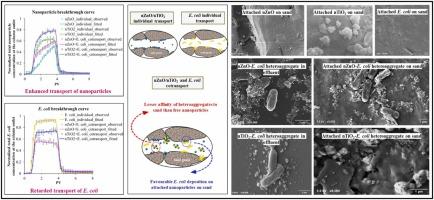Cotransport of zinc oxide and titanium dioxide nanoparticle aggregates with bacteria in saturated porous media: A coupled experimental and modeling approach
IF 11.3
1区 环境科学与生态学
Q1 ENGINEERING, ENVIRONMENTAL
引用次数: 0
Abstract
The broad application of engineered nanoparticles in various fields leads to their inevitable release into the natural environment, causing soil and groundwater contamination. Bacteria, ubiquitous in the subsurface, can alter the transport behavior of nanoparticles. Hence, it is imperative to understand the interactions between nanoparticles and bacteria in the subsurface to protect drinking water wells from contamination. This study investigated the cotransport of metal oxide nanoparticle aggregates (zinc oxide, nZnO, and titanium dioxide, nTiO2) with E. coli in saturated porous media in 1 mM NaCl and pH 8 under various flow velocities (0.26 - 1.02 cm/min) through column experiments and mathematical modeling. The injection concentrations of nanoparticles and E. coli were 15 mg/L and 107 CFU/mL, respectively. We observed enhanced transport of nZnO and nTiO2 and reduced transport of E. coli during their cotransport compared to nanoparticle-only and E. coli-only transport. The contrasting transport behaviors of nanoparticles and E. coli are due to the formation of nanoparticle-E. coli heteroaggregates, which have different transport properties than free nanoparticles and E. coli, and the preferential attachment of nanoparticles over E. coli to sand surfaces. Further, nZnO transport was enhanced to a greater extent than nTiO2 transport due to the greater rate of heteroaggregation of nZnO and E. coli in comparison to nTiO2 and E. coli. The experimental results were successfully simulated using a model that accounted for the kinetics of heteroaggregation of nanoparticles and E. coli, and heteroaggregate retention in sand.Environmental Implication
Engineered nanoparticles have significant health impacts on humans and ecosystems. Understanding their transport behavior in the subsurface is essential to protect wells from contamination. Bacteria are ubiquitous in soil and interact with nanoparticles. E. coli facilitated the transport of nanoparticles (nZnO and nTiO2), resulting in greater groundwater contamination with nanoparticles. Moreover, bacteria lead to a greater concentration of nZnO than nTiO2 in groundwater. However, the effect of bacteria on nanoparticle transport decreases with increasing groundwater velocity. Thus, the effect of co-contaminants, including bacteria, should be accounted for in assessing the risks of groundwater contamination caused by engineered nanoparticles.

饱和多孔介质中氧化锌和二氧化钛纳米颗粒聚集体与细菌的共同运输:一个耦合的实验和建模方法
工程纳米颗粒在各个领域的广泛应用导致其不可避免地释放到自然环境中,造成土壤和地下水污染。地下无处不在的细菌可以改变纳米颗粒的运输行为。因此,了解纳米颗粒与地下细菌之间的相互作用,以保护饮用水井免受污染是势在必行的。本研究通过柱实验和数学模型研究了金属氧化物纳米颗粒聚集体(氧化锌,nZnO,二氧化钛,nTiO2)在1 mM NaCl和pH 8的饱和多孔介质中,在不同流速(0.26 ~ 1.02 cm/min)下与大肠杆菌的共转运。纳米颗粒和大肠杆菌的注射浓度分别为15 mg/L和107 CFU/mL。我们观察到,与纳米颗粒和大肠杆菌的运输相比,在它们的共运输过程中,nZnO和nTiO2的运输增强,大肠杆菌的运输减少。纳米颗粒和大肠杆菌的不同运输行为是由于纳米颗粒e的形成。大肠杆菌异聚集体,具有不同于自由纳米颗粒和大肠杆菌的运输特性,以及纳米颗粒比大肠杆菌更优先附着在沙表面。此外,由于与nTiO2和大肠杆菌相比,nZnO和大肠杆菌的异聚集率更高,因此nZnO的转运能力比nTiO2的转运能力更强。利用模型成功模拟了纳米颗粒和大肠杆菌的异质聚集动力学以及异质聚集在沙子中的保留。环境影响工程纳米颗粒对人类和生态系统具有重要的健康影响。了解它们在地下的运移行为对于保护油井免受污染至关重要。细菌在土壤中无处不在,并与纳米颗粒相互作用。大肠杆菌促进了纳米粒子(nZnO和nTiO2)的运输,导致纳米粒子对地下水的污染更大。此外,细菌导致地下水中nZnO的浓度高于nTiO2。细菌对纳米颗粒运移的影响随地下水流速的增大而减小。因此,在评估由工程纳米颗粒引起的地下水污染风险时,应该考虑包括细菌在内的共污染物的影响。
本文章由计算机程序翻译,如有差异,请以英文原文为准。
求助全文
约1分钟内获得全文
求助全文
来源期刊

Journal of Hazardous Materials
工程技术-工程:环境
CiteScore
25.40
自引率
5.90%
发文量
3059
审稿时长
58 days
期刊介绍:
The Journal of Hazardous Materials serves as a global platform for promoting cutting-edge research in the field of Environmental Science and Engineering. Our publication features a wide range of articles, including full-length research papers, review articles, and perspectives, with the aim of enhancing our understanding of the dangers and risks associated with various materials concerning public health and the environment. It is important to note that the term "environmental contaminants" refers specifically to substances that pose hazardous effects through contamination, while excluding those that do not have such impacts on the environment or human health. Moreover, we emphasize the distinction between wastes and hazardous materials in order to provide further clarity on the scope of the journal. We have a keen interest in exploring specific compounds and microbial agents that have adverse effects on the environment.
 求助内容:
求助内容: 应助结果提醒方式:
应助结果提醒方式:


